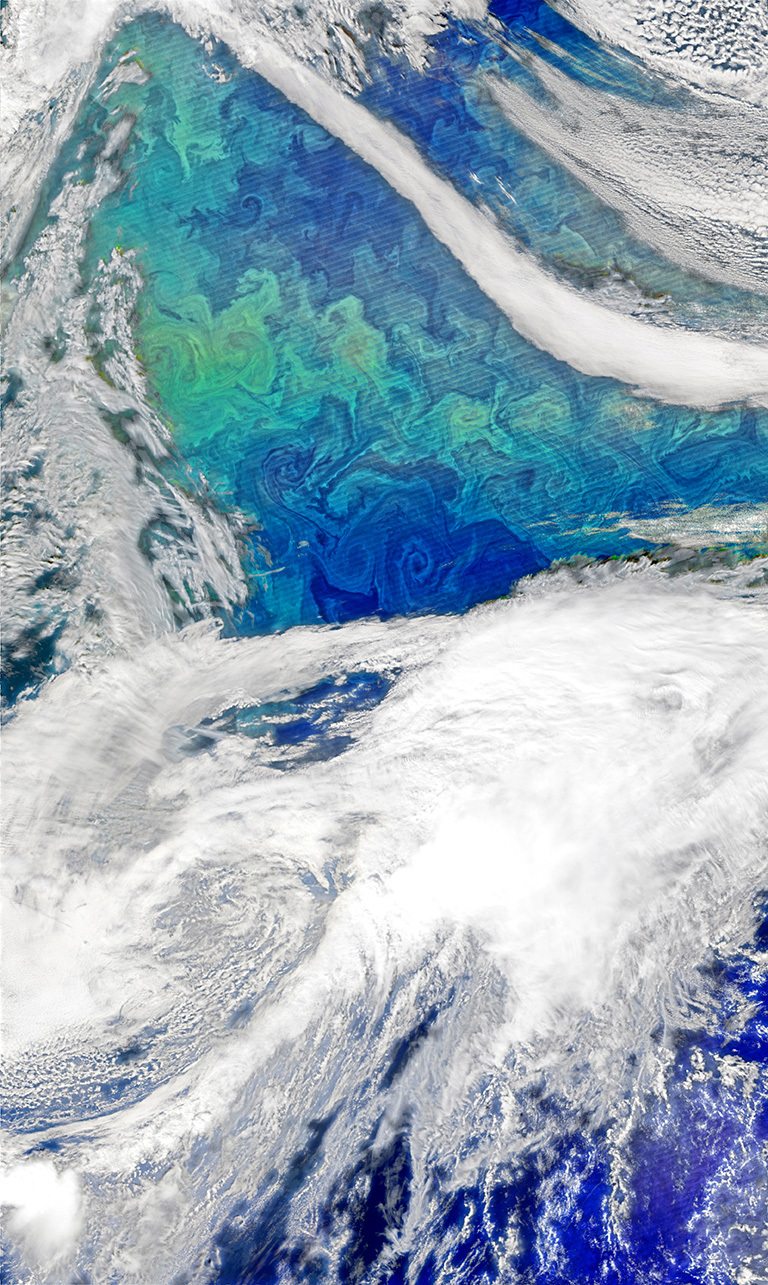Ask NASA Climate | May 6, 2016, 02:01 PDT
Plankton and you: The science of how we're all connected to climate

Each spring, the waters of the North Atlantic Ocean host a huge natural bloom of phytoplankton—microscopic, plant-like organisms that are important for carbon cycling and also could influence clouds and climate. Source: NASA's Earth Observatory. Credit: Norman Kuring, using VIIRS data from the Suomi National Polar-orbiting Partnership.
Every year toward end of the semester, when students have just finished their second round of exams and they’re irritable, burned out and just plain over it, I walk into the oceanography class I teach with “the plankton lecture.” They give me this look that says, “Aww, come on, you’ve got to be kidding.” But I’m obsessed with plankton, obsessed. And I want the whole world to know. Plankton are da bomb, plankton rule, plankton are the bestest, awesomest, sickest beasts ever.
So you can imagine how psyched I was to smack talk with plankton expert and principal investigator of NASA’s North Atlantic Aerosols and Marine Ecosystems Study (NAAMES) Mike Behrenfeld. He’s interested in the link between the blooming plankton food web and its influence on global climate. See, when animal plankton and bacteria munch on the plant plankton, organic compounds the plants produce get broken into itty bitty pieces. These small particles become aerosolized, which means they get lofted out of the ocean and into the atmosphere by wind and breaking waves, where they become the condensation nuclei around which water droplets form. So when these tiny creatures of the sea multiply, those bloom events end up influencing clouds.
The North Atlantic also has extremely particle-free air, so the restricted availability of these aerosols limits water in the atmosphere’s ability to form droplets. It's the ocean’s biology that might provide an otherwise rare opportunity for water droplets to condense around. And that means a small amount of organic aerosols can go a long way. NAAMES “is an opportunity to tie the biology and aerosols together.”
I imagined being near the ocean, inhaling the salt air, feeling the moisture on my skin, in my hair. The spray reaches up, up, up, out of the sea. And just below the surface, the churning waves and frothy foam force bits of dissolved air down between the molecules of briny water. And the oxygen in that air supports life: microbes, plankton, bacteria and the food web that eats them.
“Phytoplankton, the plant plankton, are always tightly coupled with the creatures that eat them, and there are lots of things that like to eat them,” Behrenfeld explained. Oh, I’m sure they’re delicious. “The rate at which they are dying is almost perfectly matched with how fast they grow. The faster they grow, the faster they die. The only way they can bloom is if they get away from their predators. When they grow faster than the guys eating them, they’ll bloom.”
It’s that interface, the boundary zone where the atmosphere blends into the ocean and the ocean blends back into the atmosphere, the place where mixing, churning and friction form turbulence. That’s the interesting place, physically, biologically and personally. This air-water interface is also where oceanographers stick their heads out of the water and look up toward the sky to interact with atmospheric scientists who simultaneously look down from above into the water. Behrenfeld described it as working “with people in a different discipline so you get fresh ideas from another perspective and think about things in a new way.”
Behrenfeld and the rest of the NAAMES team hope this research will help them learn how changes in climate will impact ecosystems. “If you look at blooms from a traditional standpoint, that more sunlight causes more blooms, you might expect that warming would give you a bigger bloom. But phytoplankton blooms are initiated by deep ocean mixing, and if you warm the ocean, then your winter mixing depth will be less and you might have a later onset of the bloom or a smaller bloom. The potential consequences of change in blooming areas could be huge.”
Thank you for reading and for your comments.
Laura
North Atlantic Aerosols and Marine Ecosystems Study is part of NASA Earth Expeditions, a six-month field research campaign to study regions of critical change around the world.
